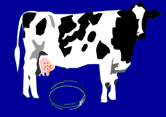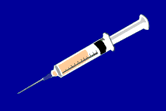
Step 1
Use the sterile petri dish to collect fluid from pustules on
the cow's udder.
|
|
To create a vaccine that will protect you against a pathogen,
you usually begin with that pathogen and alter it in some way.
Not so with smallpox. To create this vaccine, you begin with
another virus that is similar to the smallpox virus, yet
different enough not to bring on the smallpox disease once it
enters your body. This similar virus is cowpox.
The cow to the left has been intentionally infected with
cowpox virus. The fluid that you collect from virus-caused
pustules on the cow's udder contains many copies of the virus.
|

Step 2
Use the purifier to isolate the viruses.
|
|
Smallpox vaccines contains cowpox viruses but not the bacteria
and other impurities found in the fluid collected from such
pustules.
To make the vaccine, therefore, you'll need to separate the
cowpox viruses from the rest of the fluid.
|

Step 3
Fill the syringe with the purified cowpox viruses.
|
|
The smallpox vaccine is a live vaccine; the cowpox viruses it
contains will invade cells in your body, multiply, and spread
to other cells in your body, just as the smallpox viruses
would. And as with smallpox, the body's immune system will
mount an attack against the cowpox and subsequently always
"remember" what it looks like. Then, if cowpox or the similar
smallpox ever enters the body, the immune system will quickly
get rid of the invaders.
|

Done
The smallpox vaccine is complete.
|
|
Congratulations. You have just created a vaccine for smallpox.
At one time, cows were used to create the smallpox vaccine. In
fact, the decades-old stockpile in the U.S. today was made
using live calves through a process similar to the one
outlined here. Advancements in biotechnology, however, have
led to more efficient procedures that make use of bioreactors.
|

